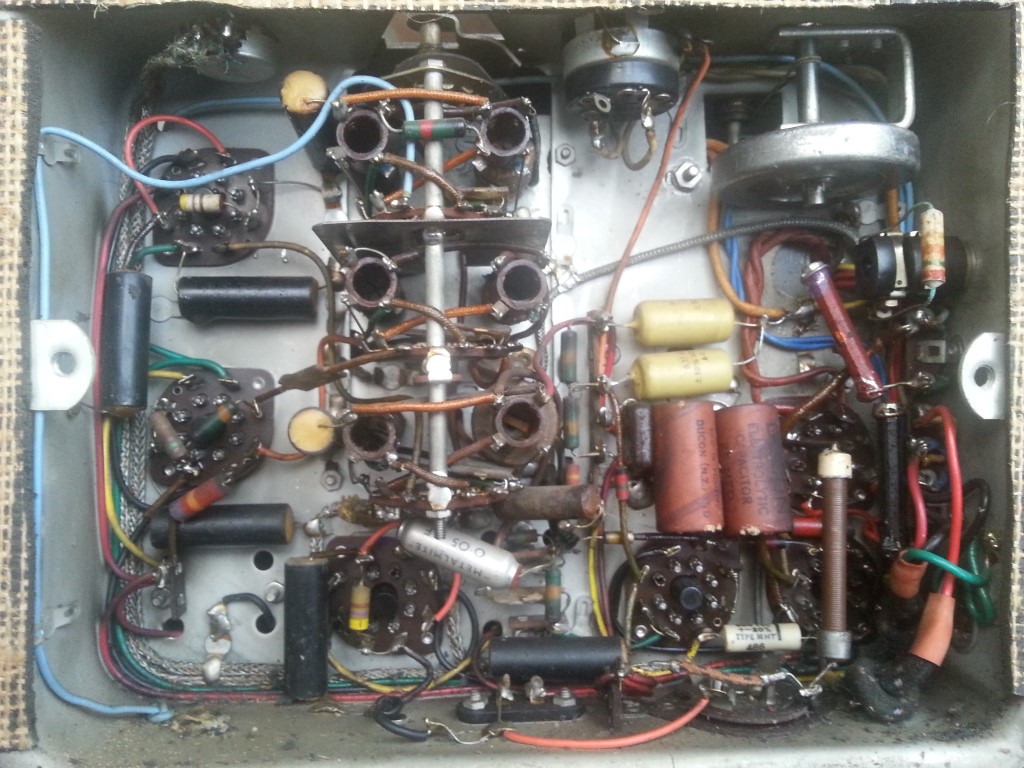Other radios based on the same chassis:
6-valve dual-wave radio - replacement for the model 66, which was in production for many years.
Released in a table radio and tablegram, as well as some radiogram models.
At least three known chassis variants - 166, 166R and 166M, also with horizontal and vertical (radiogram) dials.
Valves (6):
166: 6U7G or 6K7, 6K8G, 6U7G or 6K7, 6B8G, 6V6GT, 5Y3
166R: 6SK7, 6K8, 6K7, 6G8, 6V6, 5Y3
166M: 6BA6, 6BE6, 6BA6, 6AV6, 6AQ5, 6X4
166N: 6BA6, 6BE6, 6BA6, 6AV6, 6AQ5, 6X4
Intermediate Frequency: 455kc/s
Frequency Bands: 2
Chassis Notes(most schematics can be clicked to download a full size version)

Early octal-based chassis underside (166, 166R)
Later miniature valve underside (166M, 166N)
General Construction Notes for Radio Corporation of New Zealand Ltd:
The first digit of the serial number typically indicates the year of manufacture of RCNZ chassis' (although not the decade - that requires a little knowledge of the valves, construction, etc). Sets from around 1934 onwards were often (but not always) constructed in a distinctive pressed 'baking pan' style chassis, seemingly unique to RCNZ.
Model codes beginning with a 0, for example the model 051, are Osram valve versions of the model without the leading 0. Technically the 0 should be an O (for Osram), however the digit 0 was used throughout the site before this fact was discovered.
The E suffix indicates a magic eye option is fitted (in models which were available with or without, such as the model 25).
A and B suffixes appear to be simply updates to the current model, R also appears to be simply an updated model ('R'edesign, perhaps?)
P indicates either a permanent magnet speaker version of a model which also came with an electromagnet speaker (the model 26 for example), or a portable model (like the model 694P). This suffix was used in the mid 50's when Radio Corp was changing over.
N and M indicated miniature valve versions of a model which started with all (or a mix, ie: model 5) of larger valves. One of these two codes may indicate a transitional mixture of octal and miniature - clarification is required.
S often indicates a stereo model. It can also indicate 'self-biased' in the transition period between back-biased and self biased sets where there were models with both methods employed (53S for example)
Finally, other suffixes and prefixes make occasional appearances in the RCNZ lineup - like the 66W (a variant of the long-running model 66) and the 75XA (a 10-valve version of the model 75 with a separate amplifier chassis).
Model nicknames are often sourced from either newspaper advertising, company literature or the NZ Radio Traders Federation official trade-in price books (Particularly Courtenay models from this publication)
In 1954, model numbering changed, to begin with the number of valves (ie: 501 - 5 valves, 1006 - 10 valves, etc) although the final 2 digits don't appear to have much significance. Middle digits of 5 (portable) or 6 (mantle, including clock radio) are used on the AWA-designed plastic-cased sets.
| YEAR | MODEL NAME |
|---|---|
| 1949 | Columbus 166 Console 'Balfour' |
| 1949 | Columbus model 166 'Edinburgh' |
| 1949 | Columbus 166 Tablegram 'Pennant' |
| 1952 | Columbus model 166 'Sherwood' |
| 1949 | Columbus model 166 'Convoy' |